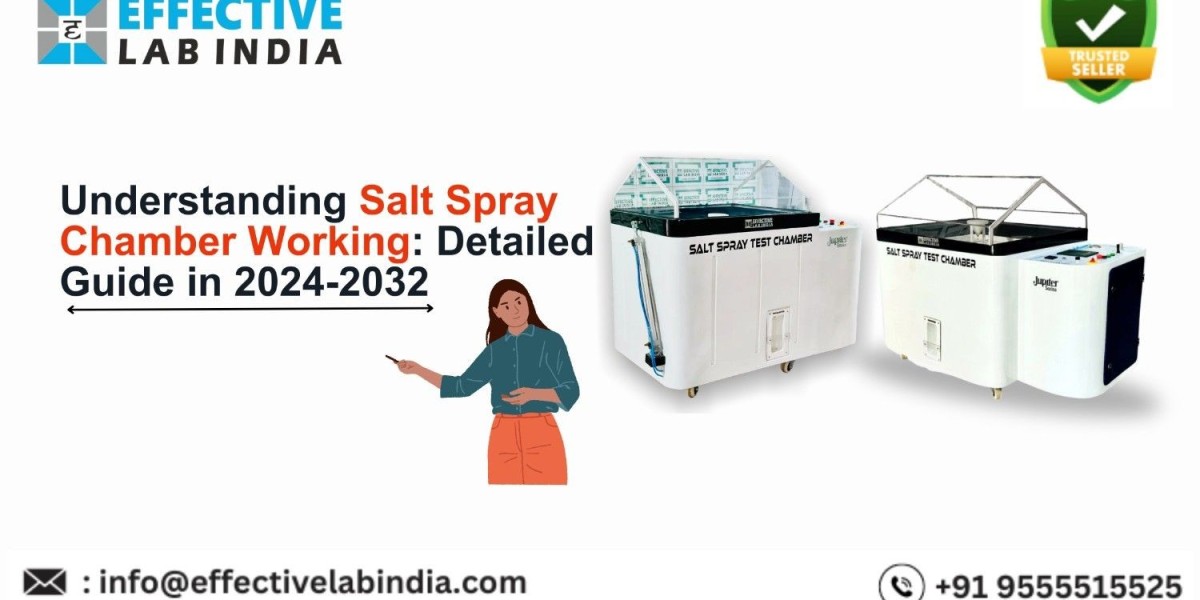Understanding Salt Spray Chamber Working: Detailed Guide in 2024-2032
When evaluating the corrosion resistance of materials, coatings, and components exposed to salty environments, salt spray chambers are essential instruments. These chambers mimic the effects of long-term exposure to saltwater or other severe circumstances by simulating accelerated corrosion through the creation of a salt fog environment. It's extremely important that you understand how these chambers work and the parameters that control the testing procedure in order to provide correct and trustworthy results.
We'll look at the inner workings of salt spray chambers, the fundamental procedures, and the significance of each part in this extensive guide. By the end, you'll know exactly how these chambers safeguard the longevity of materials and how producers use them to evaluate resistance to corrosion.
How Does a Salt Spray Chamber Work?
1. Introduction to Salt Spray Testing
Salt spray testing, also known as salt fog testing, is a type of accelerated corrosion testing method used to evaluate the protective capabilities of surface coatings on metal substrates. The salt spray chamber creates a controlled environment by spraying a saline solution onto the sample, usually a 5% sodium chloride (NaCl) solution.
This test is useful in determining a material's ability to resist corrosion and to withstand exposure to salty the environment, particularly for items that are aimed to be used in marine environments or coastal places of business.
2. Key Components of the Salt Spray Chamber
A standard salt spray chamber consists of several essential components:
Control Panel: Regulates the test cycle, temperature, and duration of the test.
Atomizing Nozzle: This nozzle converts the salt solution into a fine mist (fog) that uniformly covers the test specimens.
Solution Reservoir: Holds the saline solution used for the test.
Test Chamber: The space where the specimens are exposed to the salt fog.
Air Saturator: Prepares humid air, which is necessary for maintaining the environment.
Heaters: Ensure that the temperature inside the chamber is kept constant, often around 35°C.
3. Principle of the Salt Spray Chamber Working
The primary function of a salt spray test chamber working is to recreate a corrosive environment inside the chamber. Here’s how it works:
Preparation: The chamber is loaded with test specimens. These are typically coated metal pieces or finished products that are prone to corrosion.
Saline Solution Preparation: A solution of sodium chloride (usually 5%) is mixed with distilled water. In some tests, pH adjusters and other chemicals may be added to simulate more complex environments.
Spray Fogging: The chamber sprays a fine mist of this salt solution over the test specimens. The atomizing nozzle is crucial in ensuring the salt fog is uniformly distributed.
Test Duration: The test can last from a few hours to several weeks, depending on the standard being followed (e.g., ASTM B117, ISO 9227). Longer exposure times provide better insights into long-term durability.
Monitoring and Control: Throughout the test, the chamber maintains a set temperature (usually around 35°C) and controlled humidity levels to ensure consistent testing conditions.
Post-Test Analysis: Once the test is complete, the specimens are analysed for signs of rust, pitting, and other forms of corrosion. The results indicate the material’s ability to resist corrosion in saline conditions.
4. Applications of Salt Spray Testing
Salt spray testing is used across numerous industries:
Automotive Industry: Car parts, including exterior panels and undercarriage components, are tested for corrosion resistance to prevent rust damage over time.
Marine Applications: Ship components, including hulls, anchors, and deck fittings, are tested due to their constant exposure to seawater.
Coating Manufacturers: Protective coatings on metals are evaluated to ensure they offer long-term resistance against saltwater.
Aerospace: Aircraft parts made from aluminium and titanium alloys are subjected to salt spray testing due to the high levels of salt present at high altitudes.
Benefits of Salt Spray Testing
1. Accelerated Corrosion Testing
The acceleration of the natural corrosion process is one of the main advantages of salt spray testing. Manufacturers can replicate years of exposure in just a couple of days or weeks, as opposed to waiting months or years to observe deterioration. As a result, materials and coatings resistant to corrosion arise more quickly.
2. Consistency and Repeatability
The Salt Spray Test Chamber provide a controlled environment, ensuring that all test specimens are exposed to the same conditions. This ensures consistent and repeatable results, which is crucial for quality control and material testing.
3. Compliance with International Standards
Most salt spray tests are performed in accordance with international standards such as ASTM B117 and ISO 9227. By following these standards, manufacturers can guarantee that their products meet global corrosion resistance criteria.
FAQs on Salt Spray Chamber Working
1. How long does a typical salt spray test last?
The duration of a salt spray test varies based on the material being tested and the standard being followed. It can range from 8 hours for short-term tests to several weeks for more detailed analysis. A common test length for automotive parts is 48 to 96 hours.
2. Can salt spray testing predict real-world corrosion?
Salt spray testing is an accelerated test that provides insights into how materials might behave in salty or corrosive environments. While it simulates corrosion, it may not fully represent all factors present in real-world environments, such as UV exposure, humidity changes, or abrasion.
3. What materials are commonly tested in a salt spray chamber?
Materials tested include metals (steel, aluminium, zinc, etc.), coated metals (galvanised or painted), plastic components, and composites. Testing helps determine the durability and performance of coatings or the material itself.
4. How is corrosion measured after the test?
After the test, the specimen is examined for visual signs of rust, pitting, and other types of corrosion. Measurements such as the percentage of corroded surface area or the depth of pits can also be used to quantify the results.
5. What industries use salt spray testing?
Salt spray testing is widely used in industries like automotive, aerospace, marine, and construction to test materials, coatings, and products that are exposed to corrosive environments.
Conclusion
Salt spray chambers are a vital tool for industries needing to evaluate and ensure the corrosion resistance of materials and protective coatings. The ability to simulate long-term exposure to corrosive environments in a short time frame makes them essential in various industries, such as automotive, marine, and aerospace. By mastering how these chambers work and understanding the processes involved, manufacturers can improve product quality and durability. This ensures the safety, longevity, and performance of materials in harsh environments, thereby meeting industry standards and protecting investments.








